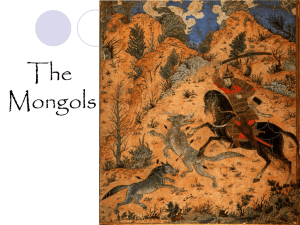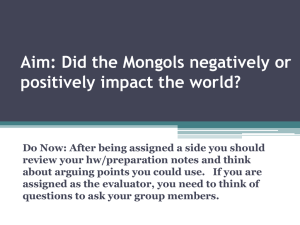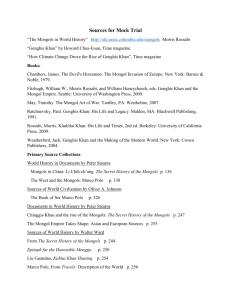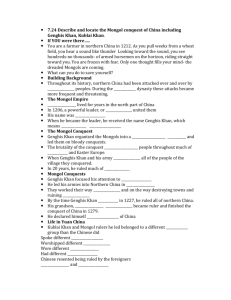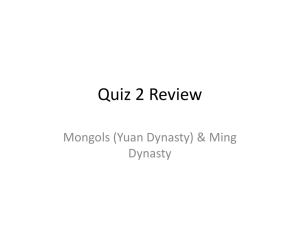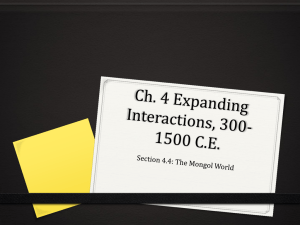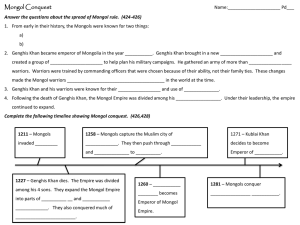Mongol and Ming Empires - Team Martinez
advertisement
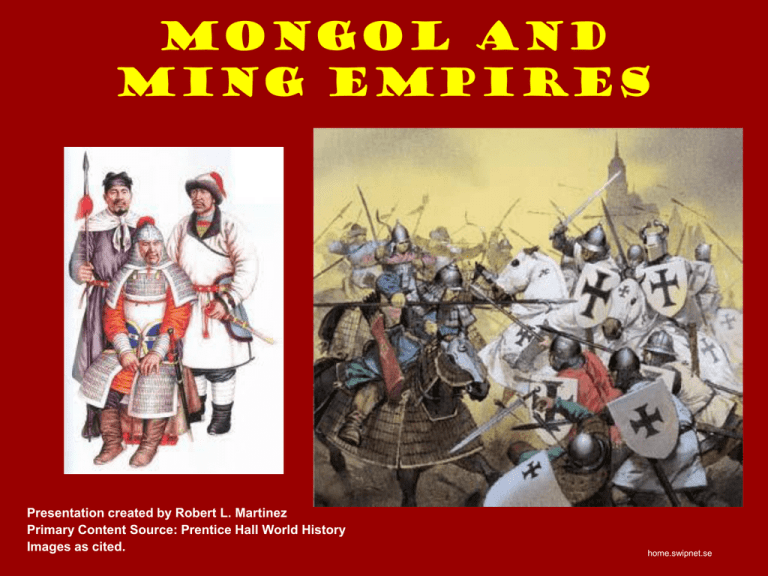
Mongol and Ming Empires Presentation created by Robert L. Martinez Primary Content Source: Prentice Hall World History Images as cited. home.swipnet.se The Mongols were a nomadic people who grazed their horses and sheep on the steppes of Central Asia. Rival Mongol clans spent much of their time warring with one another. islam-watch.org In the early 1200s, a brilliant Mongol chieftain united these warring tribes. This chieftain took the name Genghis Khan, meaning World Emperor.” Under his leadership, Mongol forces triumphantly conquered a vast empire that stretched from the Pacific Ocean in Eastern Europe. dailymail.co.uk Genghis Khan imposed strict military discipline and demanded absolute loyalty. His highly trained, mobile armies had some of the most skilled horsemen in the world. guardian.co.uk Mongol armies conquered the Asian steppe lands with some ease, but as they turned on China, they faced the problem of attacking walled cities. yuhnchinablog.blogspot.com Chinese and Turkish military experts taught them to use cannons and other new weapons. The Mongols and Chinese launched missiles against each other from metal tubes filled with gunpowder. This use of cannons in warfare would soon spread westward in Europe. twcenter.net Genghis Khan did not live to complete the conquest of China. His heirs expanded the Mongol empire. For the next 150 years, they dominated much of Asia. Their furious assaults toppled empires and spread destruction from southern Russia through Muslim lands in the Middle East to China. dipity.com In China, the Mongols devastated the flourishing province of Sichuan and annihilated its great capital city of Chengdu. chinahighlights.com Once conquest was completed, the Mongols were not oppressive rulers. Often, they allowed conquered people to live much as they had before, as long as they regularly paid tribute to the Mongols. chinadvisers.com Genghis Khan had set an example for his successors by ruling conquered lands with toleration and justice. Although the Mongol warrior had no use for city life, he respected scholars, artists, and artisans. He listened to the ideas of Confucians, Buddhists, Christians, Muslims, and Jews. cinelover.tumblr.com In the 1200s and 1300s, the heirs of Khan, established peace and order within their domain. This period is referred to as the Pax Mongolica, or Mongol Peace. en.wikipedia.org Political stability set the stage for economic growth. Under the protection of the Mongols, who now controlled the great Silk Road, trade flourished across Eurasia. jmccrackenworld.com Cultural exchanges increased as foods, tools, inventions, and ideas spread along the protected trade routes. From China, the use of windmills and gunpowder moved westward into Europe. Techniques of papermaking reached the Middle East. xtimeline.com Although, Genghis Khan had subdued northern China, the Mongols needed nearly 70 more years to conquer the south. Genghis Khan’s grandson, Kublai, toppled the last Song emperor in 1279. www.answers.com Kublai Khan ruled all of China as well as Korea, Tibet, and Vietnam. Khan tried to prevent the Mongols from being absorbed into Chinese civilizations as other conquerors of China had been. He decreed that only Mongols could serve in the military. He also reserved the highest government jobs for Mongols. velduftende.com Because there were too few Mongols to control so vast an empire, Kublai allowed Chinese officials to rule in the provinces. Under Mongol rule, an uneasy mix of Chinese and foreign ways developed. 2bangkok.com Kublai Khan rebuilt and extended the Grand Canal to his new capital, though at a terrible cost in human lives. web.sa.sc.edu The Italian merchant Marco Polo was one of many visitors to China during the Yuan dynasty. In 1271, Polo crossed Persia and Central Asia to reach China. During his stay in China, he spent 17 years in Kublai’s service. He returned to Venice by sea. yesnet.yk.ca In his writings, Marco Polo left a vivid account of the wealth and splendor of China. He described China’s efficient royal mail system, with couriers riding swift ponies along the empire’s well-kept roads. posters.co.uk The Yuan dynasty declined after the death of Kublai Khan. Most Chinese despised the foreign Mongol rulers. Heavy taxes, corruption, and natural disasters led to frequent uprisings. mrdowling.com Finally, Zhu Yuanzhang, a peasant leader, led a rebel army that toppled the Mongols, and pushed them back beyond the Great Wall. In 1368, he founded a new Chinese dynasty, which he called the Ming, meaning brilliant. drben.net Early Ming rulers sought to re-assert Chinese greatness after years of foreign rule. The Ming restored the civil service system, and Confucian learning again became the road to success. chinaknowledge.de Economically, Ming China was immensely productive. The fertile, wellirrigated plains of eastern China supported a population of more than 100 million. Better methods of fertilizing helped to improve farming. wiudwing.blogspot.com Chinese cities were home to many industries, including porcelain, paper, and tools. The Ming repaired the extensive Canal System that linked various regions and made trade easier. New technologies increased output in manufacturing. gibsonantiques.com Ming China saw a revival of arts and literature. Ming artists developed their own styles of landscape painting and created blue and white porcelain. Ming vases were among the most valuable Chinese products exported to the West. dejiantang.com In 1405, Zheng He commanded the first of seven naval expeditions. He led a fleet of 62 ships and hundreds of smaller ones, carrying a crew of more than 25,000 sailors. The goal of each expedition was to promote trade and collect tribute from lesser powers across the “western seas.” althistory.wikia.com


